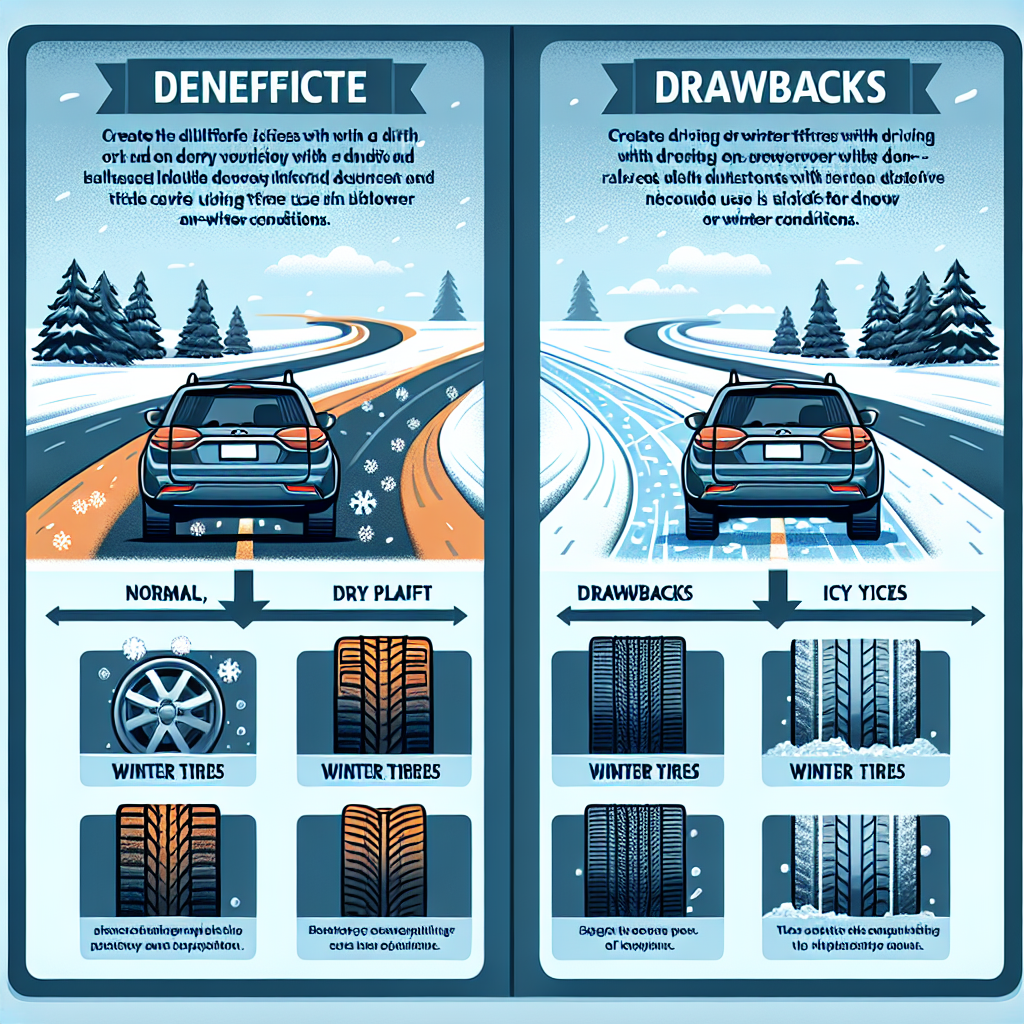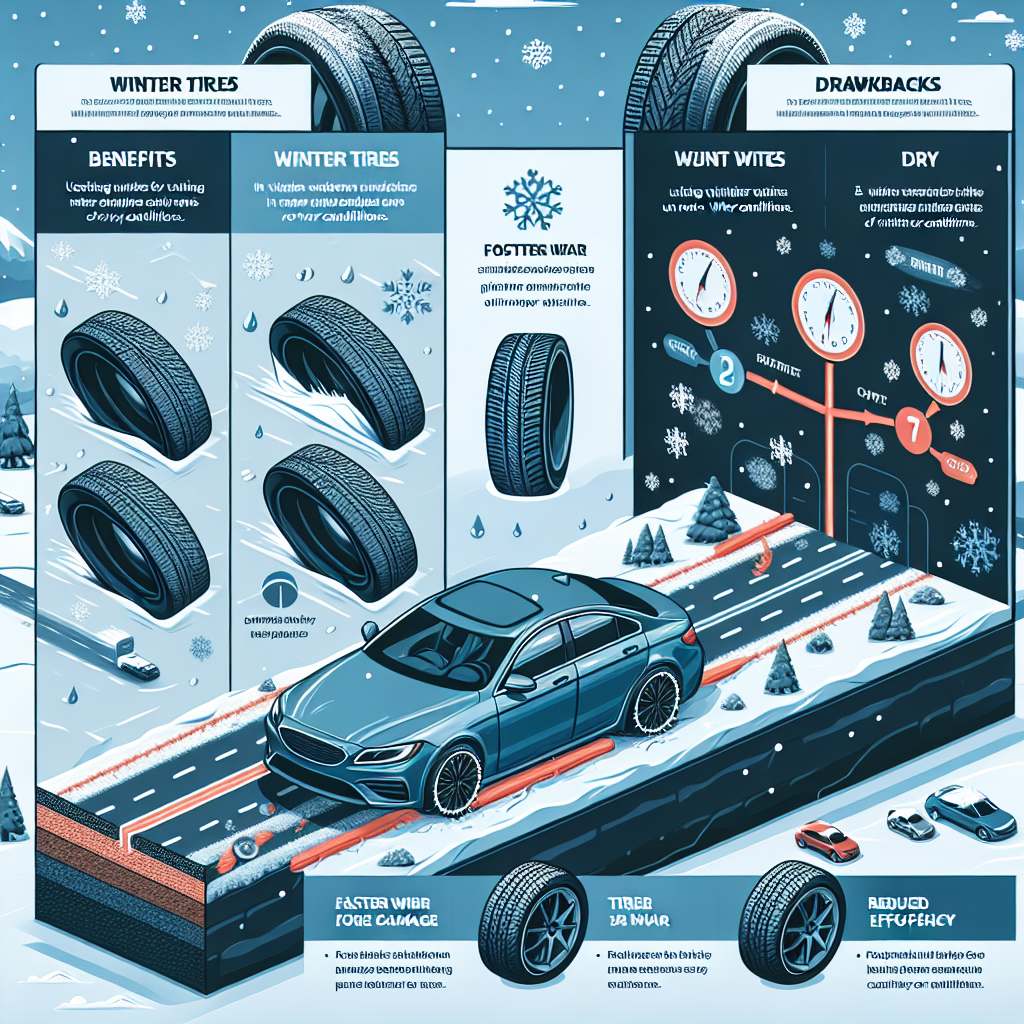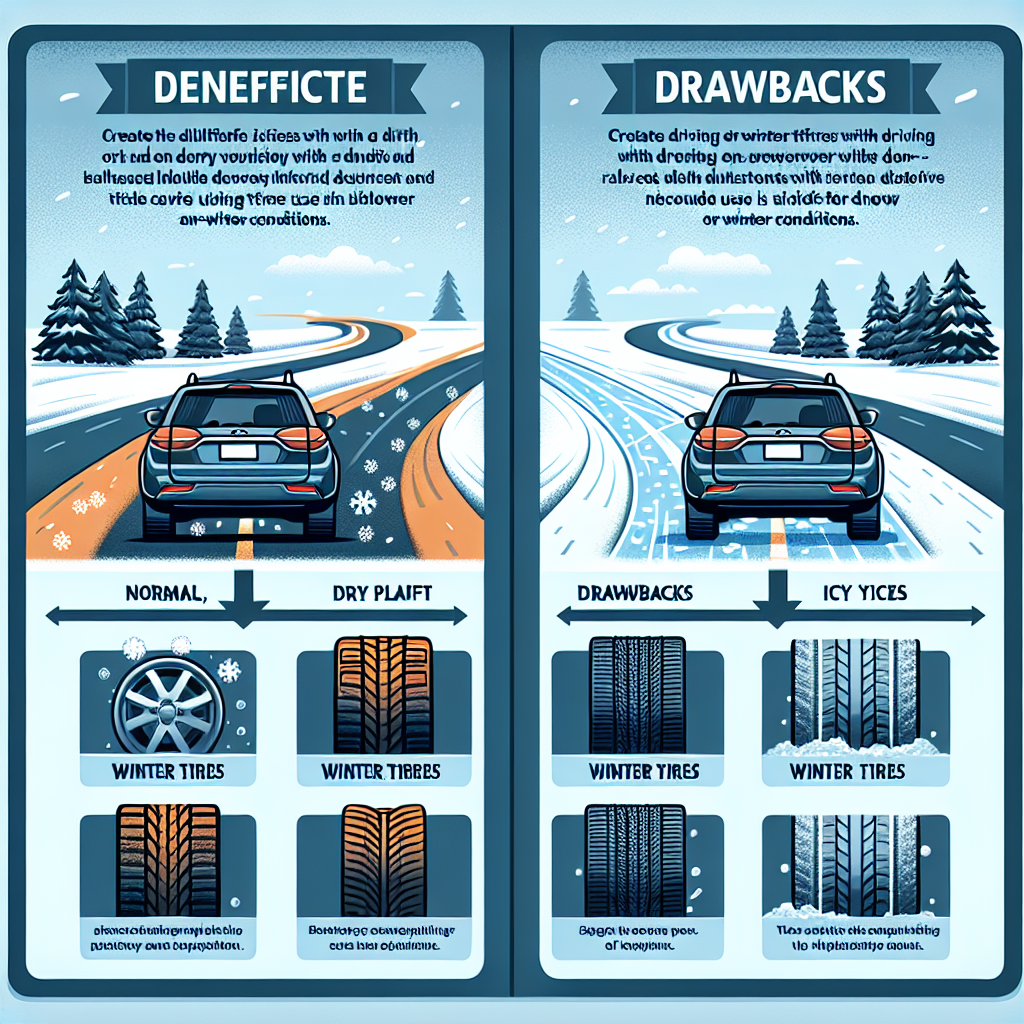When it comes to driving with winter tires on dry pavement, you may find yourself wondering if there are any recommendations to keep in mind. While it’s common knowledge that winter tires excel in snowy and icy conditions, you might be uncertain about how they perform on dry roads. This article aims to provide you with valuable insights and tips to ensure a safe and smooth driving experience with winter tires, even when the pavement is dry. So, let’s put any doubts to rest and learn how to make the most out of your winter tires, no matter the road conditions.

Choosing the right winter tires
When it comes to choosing the right winter tires, there are a few things you should consider. First, think about the tire type and tread pattern. Winter tires come in different types, such as studless, studded, or performance winter tires. Each type has its advantages and disadvantages, so it’s important to choose the one that best suits your needs and driving conditions.
The tread pattern is another crucial factor to consider. Winter tires usually have deeper tread patterns, which help to improve traction on snowy and icy roads. Look for tires with grooves and sipes designed to enhance grip and channel away water and slush.
Additionally, ensure that you select the correct tire size and load rating for your vehicle. Checking your vehicle’s owner’s manual or consulting with a tire specialist can help you determine the appropriate tire size and load rating for optimal performance and safety.
Lastly, look for the mountain snowflake symbol on the tire sidewall. This symbol indicates that the tire has met specific requirements for snow traction performance, making it a reliable choice for winter driving.
Installing winter tires correctly
Installing your winter tires correctly is crucial to ensure their effectiveness and longevity. Follow the manufacturer’s recommended procedure for mounting and balancing the tires. This process may vary depending on the type and brand of tires you choose, so it’s essential to refer to the manufacturer’s instructions.
Once the tires are properly installed, remember to check the tire pressures regularly. Cold temperatures can cause the air pressure in your tires to drop, which can affect their performance and handling. Use a reliable tire pressure gauge to monitor and maintain the ideal pressure recommended by the tire manufacturer.
Additionally, inspect your winter tires for any signs of damage or wear. Look for cuts, bulges, or uneven tread wear, as these can affect the tire’s grip and stability. If you notice any issues, it’s crucial to address them promptly to ensure your safety on the road.
Driving smoothly with winter tires on dry pavement
While winter tires are designed for snowy and icy conditions, you may find yourself driving on dry pavement during the winter season. To drive smoothly with winter tires on dry roads, keep the following tips in mind:
-
Avoid sudden acceleration and braking. Winter tires have softer rubber compounds and deeper tread, which can impact their performance on dry pavement. Gradual acceleration and gentle braking help maintain stability and prevent skidding.
-
Maintain a safe following distance. As with any driving situation, it’s important to leave enough space between you and the vehicle in front of you. This allows for ample reaction time in case of sudden stops or emergencies.
-
Be cautious while cornering. Winter tires have more aggressive tread patterns, which may cause the tires to make more noise and generate some vibrations on dry roads. Take turns at a moderate speed to maintain control and prevent any potential loss of traction.
Proper care and maintenance
Proper care and maintenance of your winter tires are essential to ensure their longevity and optimal performance throughout the winter season. Here are a few maintenance tips to keep in mind:
Regularly check the tire pressure to ensure it remains at the recommended level. Cold temperatures can cause fluctuations in tire pressure, so it’s crucial to monitor and adjust it accordingly. An underinflated tire can affect handling and increase the risk of accidents, while an overinflated tire may reduce traction.
Rotate the tires periodically to promote even wear. Front tires tend to wear differently than rear ones due to different driving forces and weight distribution. By rotating the tires, you can extend their lifespan and maintain consistent performance.
During the offseason, it’s important to store your winter tires properly. Clean them thoroughly and store them in a cool, dry place away from direct sunlight. Use tire storage bags or covers to protect them from dust, oils, and other contaminants. Storing your winter tires correctly ensures that they will be in good condition for the next winter season.

Understanding the limitations of winter tires on dry pavement
Winter tires are specifically designed for snowy and icy conditions, so they do have some limitations when it comes to performance on dry pavement. Here are a few factors to be aware of:
-
Reduced braking performance: Winter tires have softer rubber compounds, which can decrease their braking efficiency on dry roads compared to all-season or summer tires. It’s important to adjust your driving style and allow for longer braking distances.
-
Decreased handling and response: The aggressive tread patterns on winter tires may lead to reduced handling and responsiveness on dry pavement. You may experience some noise and vibrations while driving, but this is normal for winter tires.
-
Increased tire wear: Winter tires are designed to provide maximum traction on snow and ice, which can result in increased wear on dry roads. It’s crucial to monitor the tire tread depth, and if it reaches the minimum legal requirement, consider replacing the tires to maintain optimal performance.
Despite these limitations, winter tires still offer better traction and safety compared to all-season tires when driving in winter conditions. It’s essential to understand their capabilities and adjust your driving accordingly.
Monitoring weather conditions
Weather conditions can change rapidly during the winter season, so it’s important to stay prepared and adjust your driving according to the current weather. Here are a few tips to help you stay safe on the road:
-
Be prepared for unexpected weather changes. Keep an eye on weather forecasts and be prepared for sudden snowstorms or freezing rain. Having an emergency kit in your vehicle with essentials like a flashlight, extra blankets, and a shovel can help you stay prepared in case of an unexpected situation.
-
Consider switching to all-season tires if needed. If you live in an area where the winter season is mild and snowfall is infrequent, you may consider using all-season tires instead of winter tires. All-season tires provide adequate traction in light snow and slush, making them a more practical choice for some regions.
-
Pay attention to temperature fluctuations. Winter tires are designed to perform best in cold temperatures. As temperatures rise above freezing, their performance may decrease. If you notice a significant increase in temperature, it’s important to monitor road conditions and adjust your driving accordingly.

Driving techniques for icy or snowy patches
Encountering icy or snowy patches on the road requires specific driving techniques to ensure your safety. Here are a few tips to help you navigate these challenging conditions:
-
Maintain a slow and steady speed. Accelerating or decelerating too quickly can cause your tires to lose grip on icy surfaces. Drive at a moderate speed to maintain control and minimize the risk of skidding.
-
Avoid abrupt steering movements. Make gentle and gradual turns to maintain stability. Sudden movements can cause your vehicle to lose control on slippery roads.
-
Use caution on bridges and overpasses. These structures tend to freeze before the rest of the road, so approach them with caution. Reduce your speed and avoid sudden braking or acceleration while crossing them.
Assessing road conditions
Being aware of road conditions is essential for safe winter driving. Here are a few things to keep in mind when assessing road conditions:
-
Be aware of black ice. Black ice is a transparent layer of ice that forms on the road and is difficult to detect. It can be especially dangerous as it reduces traction significantly. Watch for areas that appear glossy or darker than the surrounding pavement, and approach them cautiously.
-
Watch out for uneven surfaces. Snow and ice can cover potholes and other irregularities in the road, making them difficult to see. Be vigilant and scan the road ahead for any potential hazards.
-
Scan for potholes and debris. Winter conditions can cause potholes to form or worsen on roads. These can damage your winter tires or cause a loss of control. Keep an eye out for potholes and debris, and try to avoid them whenever possible.

Seeking professional advice
If you’re unsure about any aspect of winter tire selection, installation, or maintenance, it’s always a good idea to seek professional advice. Consult with a tire specialist who can provide guidance based on your specific vehicle and driving conditions. They can help you choose the right winter tires and ensure they are installed correctly for optimal performance and safety.
Additionally, consider visiting a reputable mechanic for regular inspections and maintenance. They can assess the overall condition of your vehicle, including the tires, and identify any issues that need to be addressed.
Another valuable source of advice is experienced winter drivers. Reach out to friends, family, or colleagues who have been driving in winter conditions for a long time. They can share their knowledge and provide valuable insights into driving techniques and precautions specific to your area.
Understanding the legal requirements
It’s important to familiarize yourself with the local regulations and legal requirements regarding winter tires. Different regions have specific laws and guidelines, so it’s crucial to comply with these for your safety and to avoid any legal issues.
Check the local regulations in your area to determine whether winter tires are mandatory during certain months or under specific weather conditions. Familiarize yourself with the requirements regarding tire markings and labels, as these indicate compliance with safety standards.
Additionally, some areas have laws related to seasonal tire changeover, requiring drivers to switch to winter tires within specific timeframes. Be sure to comply with these laws and schedule your tire changeover accordingly.
By understanding the legal requirements and ensuring compliance, you can drive confidently and safely during the winter season.
In conclusion, choosing the right winter tires, installing them correctly, and driving with the appropriate techniques are crucial for safe winter driving. Proper care and maintenance, monitoring weather conditions, assessing road conditions, seeking professional advice when needed, and understanding the legal requirements will all contribute to a safe and comfortable winter driving experience. Stay vigilant, be prepared, and prioritize safety on the road.


